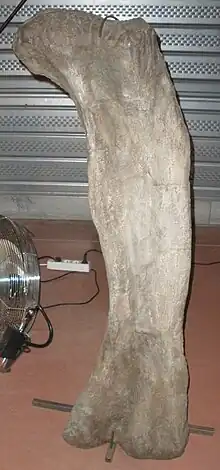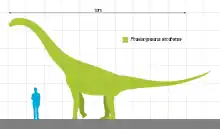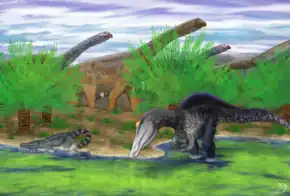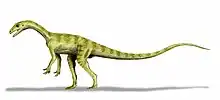Phuwiangosaurus
Phuwiangosaurus (meaning "Phu Wiang lizard") is a genus of titanosaur dinosaur from the Early Cretaceous (Valanginian-Hauterivian) Sao Khua Formation of Thailand. The type species, P. sirindhornae, was described by Martin, Buffetaut, and Suteethorn in a 1993 press release[1] and was formally named in 1994.[2] The species was named to honor Princess Maha Chakri Sirindhorn of Thailand, who was interested in the geology and palaeontology of Thailand, while the genus was named after the Phu Wiang area, where the fossil was discovered.
| Phuwiangosaurus | |
|---|---|
 | |
| Femur | |
| Scientific classification | |
| Domain: | Eukaryota |
| Kingdom: | Animalia |
| Phylum: | Chordata |
| Clade: | Dinosauria |
| Clade: | Saurischia |
| Clade: | †Sauropodomorpha |
| Clade: | †Sauropoda |
| Clade: | †Macronaria |
| Family: | †Euhelopodidae |
| Genus: | †Phuwiangosaurus Martin, Buffetaut and Suteethorn, 1994 |
| Type species | |
| †Phuwiangosaurus sirindhornae Martin, Buffetaut and Suteethorn, 1994 | |
Phuwiangosaurus was originally assigned to Titanosauria, but more recent studies have placed it in a more basal position within the Titanosauriformes. Phylogenetic analyses presented by D'Emic (2012), Mannion et al. (2013), and Mocho et al. (2014) resolve Phuwiangosaurus within the Euhelopodidae, alongside genera such as Euhelopus and Tangvayosaurus.[3][4][5] Other analyses have failed to find support for such a grouping,[6] including some finding it to be paraphyletic at the base of Somphospondyli.[4][7]
Discovery and naming
The type specimen of Phuwiangosaurus sirindhornae was discovered in Phu Wiang National Park in 1982, and excavated and prepared over the next several years. The specimen was described as representing a new genus and species, Phuwiangosaurus sirindhornae, by Valérie Martin, Eric Buffetaut, and Varavudh Suteethorn in 1994. The genus name refers to its discovery in Phu Wiang, and the species name honors Princess Maha Chakri Sirindhorn of Thailand for her interest in the paleontology of the country.[8]
Fossil specimens
Phuwiangosaurus sirindhornae is known from several specimens, all of which were found in the Sao Khua Formation of Thailand.[9][10][11] The holotype, SM PW 1, is a partial skeleton of an adult individual, which consists of three cervical vertebrae, three dorsal vertebrae, ribs, a chevron, both scapulae, a coracoid, the left humerus, the left ulna, both ilia, ischia, pubes, and femora, and the left fibula.[12] A dorsal vertebra and a caudal vertebra excavated at the same site years later probably belong to the same specimen.[13] The most complete skeleton, SM K11, represents a half-grown individual and is about 60% complete, including a partial skull.[14] Other partial skeletons and isolated bones have been described as well.[9][11] In 2020, Cashmore et al. calculated that, overall, 65% of the skeletal anatomy of Phuwiangosaurus sirindhornae was known.[15] Numerous bones of baby Phuwiangosaurus have been found, which is a rarity for sauropods.[16] Though specimens of a wide range of ages are known, no old individuals that had reached their maximum body size are known.[17]
Description

Phuwiangosaurus was a mid-sized sauropod, roughly 15 to 20 metres (49 to 66 ft) long.[18] Its mass has been estimated at 17 tonnes.[19] The teeth are slender and peg-like, with the tooth height from base to tip being on average over four times greater than the width of the base of the tooth. They are slenderer than the teeth of other euhelopodids, with their proportions more closely resembling the teeth of diplodocoids and titanosaurs.[20] The neck of Phuwiangosaurus was probably composed of 13 vertebrae. The lengths of the vertebrae increase up to the middle of the neck, with the eighth cervical vertebra being the longest, and then decrease again. The cervical neural spines are bifurcated from the seventh cervical vertebra onward.[21] The sacrum was composed of five vertebrae.[22]
Paleoecology

The Sao Khua Formation, where fossils of Phuwiangosaurus have been found, was deposited 133.6 to 132.1 million years ago, and represents a floodplain environment in a humid, subtropical climate.[23] The Sao Khua dinosaur assemblage includes the large theropods Siamotyrannus, Phuwiangvenator, Vayuraptor, and Siamosaurus, and the ornithomimosaur Kinnareemimus.[24] Other unidientified sauropods, different from Phuwiangosaurus, were present in the ecosystem. These sauropods include a Euhelopus-like taxon[25] and a possible brachiosaurid.[11] Ornithischian dinosaurs are not known from the Sao Khua Formation, although they are known from roughly contemporary environments in other parts of Asia.[26] Non-dinosaurian members of the fauna included crocodilians, turtles, fish, and sharks.[11] There is evidence that theropods fed on Phuwiangosaurus.[27]
References
- Martin, V.; E. Buffeataut; V. Suteethorn (1993). "Jurassic sauropod dinosaurs of Thailand: a preliminary report". In T. Thanasutipital (ed.). Proceedings of the International Symposium on Biostratigraphy of mainland Southeast Asia. Chiang Mai University. pp. 415–425.
- Martin, V.; E. Buffeataut; V. Suteethorn (1994). "A new genus of sauropod dinosaur from the Sao Khua formation (Late Jurassic or early Cretaceous) of northeastern Thailand". Comptes rendus de l'Académie des Sciences de Paris. 319 (2): 1085–1092.
- D'Emic, M. D. (2012). "The early evolution of titanosauriform sauropod dinosaurs". Zoological Journal of the Linnean Society. 166 (3): 624–671. doi:10.1111/j.1096-3642.2012.00853.x.
- Mannion, P. D.; Upchurch, P.; Barnes, R. N.; Mateus, O. (2013). "Osteology of the Late Jurassic Portuguese sauropod dinosaur Lusotitan atalaiensis (Macronaria) and the evolutionary history of basal titanosauriforms". Zoological Journal of the Linnean Society. 168: 98–206. doi:10.1111/zoj.12029.
- Mocho, P.; Royo-Torres, R.; Ortega, F. (2014). "Phylogenetic reassessment of Lourinhasaurus alenquerensis, a basal Macronaria (Sauropoda) from the Upper Jurassic of Portugal". Zoological Journal of the Linnean Society. 170 (4): 875–916. doi:10.1111/zoj.12113.
- D'Emic, M. D. (2013). "Revision of the sauropod dinosaurs of the Lower Cretaceous Trinity Group, southern USA, with the description of a new genus". Journal of Systematic Palaeontology. 11 (6): 707–726. doi:10.1080/14772019.2012.667446. S2CID 84742205.
- Zaher, H.; Pol, D.; Carvalho, A.B.; Nascimento, P.M.; Riccomini, C.; Larson, P.; Juarez-Valieri, R.; Pires-Domingues, R.; da Silva Jr, N.J.; de Almeida Campos, D. (2011). "A complete skull of Early Cretaceous sauropod and the evolution of advanced titanosaurians". PLOS ONE. 6 (2): e16663. Bibcode:2011PLoSO...616663Z. doi:10.1371/journal.pone.0016663. PMC 3034730. PMID 21326881.
- Martin, Buffetaut & Suteethorn 1994, p. 1089.
- Martin, Suteethorn & Buffetaut 1999.
- Suteethorn et al. 2009.
- Samathi et al. 2023.
- Suteethorn et al. 2009, pp. 195.
- Suteethorn et al. 2010, p. 116.
- Suteethorn et al. 2009, pp. 193–195.
- Cashmore et al. 2020.
- Martin 1994, pp. 151.
- Klein, Sander & Suteethorn 2009, pp. 225–226.
- Martin, Suteethorn & Buffetaut 1999, p. 42.
- Paul 2010, p. 205.
- D'Emic et al. 2013, p. 27.
- Suteethorn et al. 2009, p. 203.
- Suteethorn et al. 2009, p. 207.
- Tucker et al. 2022.
- Tucker et al. 2022, p. 15.
- Buffetaut et al. 2002, p. 99.
- Tucker et al. 2022, p. 17.
- Suteethorn et al. 2009, pp. 193–194.
Works cited
- Cashmore, Daniel; Mannion, Philip; Upchurch, Paul; Butler, Richard (2020-07-15). "Data from: Ten more years of discovery: revisiting the quality of the sauropodomorph dinosaur fossil record". Dryad. doi:10.5061/dryad.6hdr7sqxb. Retrieved 2023-05-29.
- D'Emic, Michael D.; Mannion, Philip D.; Upchurch, Paul; Benson, Roger B. J.; Pang, Qiqing; Cheng, Zhengwu (2013-08-02). "Osteology of Huabeisaurus allocotus (Sauropoda: Titanosauriformes) from the Upper Cretaceous of China". PLoS ONE. 8 (8). doi:10.1371/journal.pone.0069375. ISSN 1932-6203. PMC 3732233.
- Klein, Nicole; Sander, Martin; Suteethorn, Varavudh (2009). "Bone histology and its implications for the life history and growth of the Early Cretaceous titanosaur Phuwiangosaurus sirindhornae". Geological Society, London, Special Publications. 315 (1): 217–228. doi:10.1144/SP315.15. eISSN 2041-4927. ISSN 0305-8719.
- Martin, Valérie (1994). "Baby sauropods from the Sao Khua Formation (Lower Cretaceous) in northeastern Thailand". Gaia. 10: 147–153. ISSN 0871-5424.
- Martin, Valérie; Buffetaut, Eric; Suteethorn, Varavudh (1994). "A new genus of sauropod dinosaur from the Sao Khua Formation (Late Jurassic or Early Cretaceous) of northeastern Thailand". Comptes rendus de l'Académie des sciences. Série II. Sciences de la terre et des planètes. 319 (9): 1085–1092. ISSN 1251-8050.
- Martin, V.; Suteethorn, V.; Buffetaut, E. (1999). "Description of the type and referred material of Phuwiangosaurus sirindhornae Martin, Buffetaut and Suteethorn, 1994, a sauropod from the Lower Cretaceous of Thailand". Oryctos. 2: 39–91.
- Paul, Gregory S. (2010). The Princeton Field Guide to Dinosaurs. New Jersey: Princeton University Press. ISBN 9780691137209.
- Samathi, Adun; Suteethorn, Suravech; Boonjarern, Tanachot; Sutcha, Krishna; Suteethorn, Varavudh (2023-03-24). "Dinosaur fauna from the Lower Cretaceous of Phu Kao-Phu Phan Kham, northeastern Thailand: A review and update". Palaeoworld. doi:10.1016/j.palwor.2023.03.007. ISSN 1871-174X.
- Suteethorn, S.; Le Loeuff, J.; Buffetaut, E.; Suteethorn, V.; Talubmook, C.; Chonglakmani, C. (2009). "A new skeleton of Phuwiangosaurus sirindhornae (Dinosauria, Sauropoda) from NE Thailand". Geological Society, London, Special Publications. 315 (1): 189–215. doi:10.1144/SP315.14. eISSN 2041-4927. ISSN 0305-8719.
- Suteethorn, Suravech; Le Loeuff, Jean; Buffetaut, Eric; Suteethorn, Varavudh (2010-04-01). "Description of topotypes of Phuwiangosaurus sirindhornae, a sauropod from the Sao Khua Formation (Early Cretaceous) of Thailand, and their phylogenetic implications". Neues Jahrbuch für Geologie und Paläontologie - Abhandlungen. 256 (1): 109–121. doi:10.1127/0077-7749/2010/0036. ISSN 0077-7749.
- Tucker, Ryan T.; Hyland, Ethan G.; Gates, Terry A.; King, M. Ryan; Roberts, Eric M.; Foley, Elliot K.; Berndt, David; Hanta, Rattanaphorn; Khansubha, Sasa-on; Aswasereelert, Wasinee; Zanno, Lindsay E. (2022-06-13). "Age, depositional history, and paleoclimatic setting of Early Cretaceous dinosaur assemblages from the Sao Khua Formation (Khorat Group), Thailand". Palaeogeography, Palaeoclimatology, Palaeoecology. 601: 111107. doi:10.1016/j.palaeo.2022.111107. ISSN 0031-0182.










